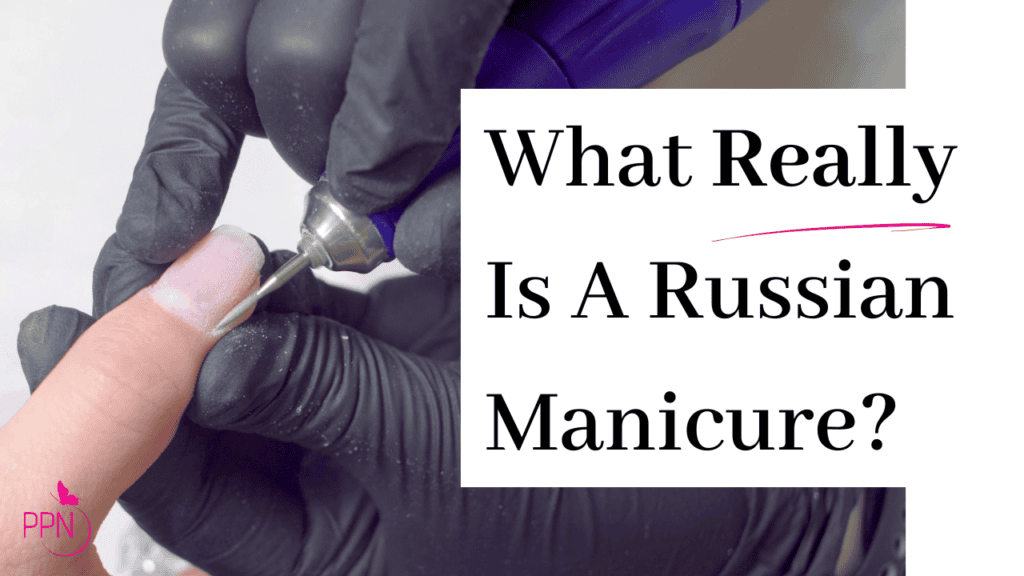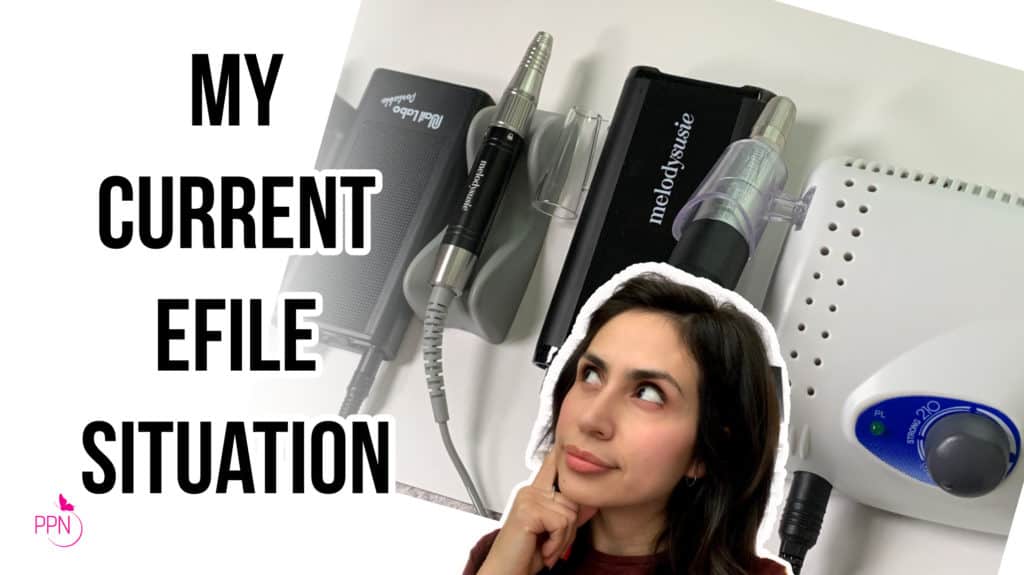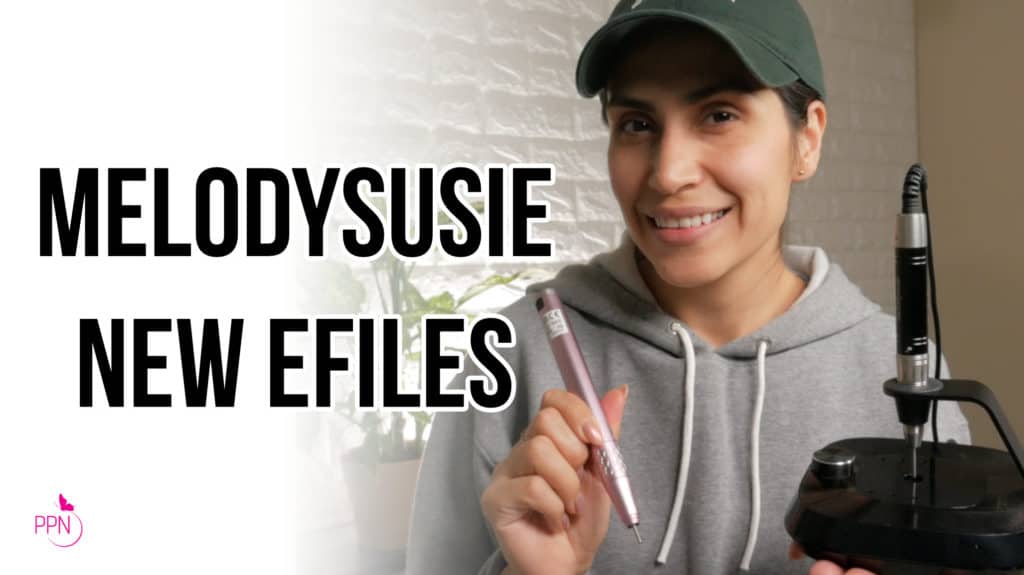You’re seeing it everywhere! On socials, on Bios, on service menus.
The Russian Manicure.
But what is it really, and how do you know you’re actually getting one when getting your nails done?
I’ve had the opportunity to attend two “Russian Manicure” training sessions during my career.
One was in a group class setting, and the other one was a 1:1 training w/ Anastasia of Nailcou.
What is a Russian Manicure?
In essence the Russian Manicure is a meticulous efile manicure that originated in Eastern Europe. Because it uses cutting implements, not just efile bits to get the nail prep done, it is also known as a Combination, or combi, manicure for short.
After the intense efile prep, the manicure continues with a structured gel overlay application.
And I’m going to assume by the name, that it was primarily performed by technicians of Russian heritage. Both of my instructors did happen to be Russian.
What is NOT a Russian Manicure?
A Russian Manicure is not synonymous with the word dry efile manicure. A manicure where a nail technician grabs their electric file machine and diamond bits to exfoliate the skin.
So please, please don’t just assume that because a nail tech is using bit attachments to prep your nail and exfoliate dry skin that that is a Russian Manicure.
Thanks, or no thanks, to the super fast flow of information via social media, the Russian Manicure is now making its way across salons all over the world.
But in the US at least, it remains a controversial topic as it crosses the line as to what manicurists are legally allowed to do to the skin, when performing nail services.
So if you are a nail tech in the US where we have state board, by labeling yourself or your service “Russian Manicure”, you may be signaling to the board to come and pay you a visit.
In any case, the Russian Manicure should NEVER be attempted by someone with little to no experience with an efile. It is not beginner friendly at all.
If you think you’re going to watch a video and try to do it yourself… Don’t do it.
Even someone that has been doing nails for a while, needs time and training to get comfortable with the procedure… so to think you’re going to get it having touched an efile 3 times this year… Yeah.
Today we’ll describe some of the classic procedures in the Russian Manicure, but I’ll just give you my opinion upfront, even if it was totally legit in the US to do the full extent of a Russian Mani… I still wouldn’t care to offer it, and I didn’t, even once I was trained.
I’ll tell you why at the end of this video, so make sure to stick around.
Alright, alright… let me not spoil anything, and get into it.

Let’s break down the Russian Manicure by noting and describing its 6 classic characteristics. If you’re only hitting two or three of these, you are not getting a TRUE Russian Manicure.
🌿 Classic Characteristic #1: Sterilized tools.
The Russian Manicure gets a little surgical.
There is cutting and deep exfoliation involved, which is why Russian Manicure techs opt for hot sterilization of their tools. That is a big expense in itself guys, so do expect a higher tag on this service in the salon for just this reason.
And so if the tools aren’t coming out of a sterilizing mechanism, you’re either not going to get a Russian Manicure, regardless of what you asked, or maybe you are but perhaps just with disinfected tools not sterilized ones.
🌿 Classic Characteristic #2: Opening “the pocket”
Yes, you’re not only opening up your pocket financially for this service… there’s a different pocket you’ll be opening characteristic of this Russian Manicure Service.
Here it is…
The most notable characteristic of the Russian Manicure, is to create a void, commonly known as “the pocket”, underneath the cuticle area, to make the gel look like it’s growing out of the matrix.
A little obsessive… sure.
Either way, creating the pocket, that void underneath the lateral nail fold is done with both a cuticle pusher and an efile bit.
The quality of both is important.
The pusher is no regular, ordinary, or cheap cuticle pusher.
In my trainings I learned that the nail pusher is actually sharpened on both ends. Yes, sharpened, not dull or thick. And this is because you’re going to use it to get in between the cuticle on the nail plate and the eponychium of the nails. The goal is to separate the two because you’ll be doing different prep work on them. The eponychium and the cuticle.
(Yes, the appointment time just got that much longer.)
Opening the pocket requires knowing nail anatomy, and their important role to ensure… no one gets hurt.
To further open the pocket, you’ll be using an electric file bit.
Which leads me to…
🌿 Classic Characteristic #3: The use of a diamond flame bit.
A diamond flame bit is an efile bit that has a little round belly and ends in a point. There are varying shapes and sizes for this flame bit, but the medium-sized one, in fine grit, is the more standard.
The purpose of this flame bit is two fold.
The point exfoliates the dry skin on the nail plate. The surface of the belly exfoliates the folds around the nail.
I’ve seen this flame bit tucked way underneath the proximal fold of the nail… to get dry skin from underneath there… and I’m just like WHY!!
Who the … is looking or noticing the skin underneath there! And first of all, it belongs there to protect against contaminants.
Either way. A quality authentic diamond flame bit. Classic characteristic of a Russian Manicure.
🌿 Classic Characteristic #4: Overnipping or cutting the eponychium.
Many times clients will have scraggly eponychium, and it is our job to trim and exfoliate it to improve the appearance of the client’s manicure. This is why they come to see us PROs, for us to do it for them, and safely.
However, a Russian Manicure typically is done with nail scissors, and while these can be used safely to trim what you need. Often the trimming just goes beyond cutting scraggly eponychium or hangnails, and into live tissue.
It’s that over-trimming of the skin surrounding the nail that makes it a characteristic of a Russian Manicure, and a controversial one at that.
Whether this is allowed in your country or not, it is important for you to know that anytime you break skin, you essentially provoke the skin to protect itself, and it does this by growing more skin and even callusing.
And we just don’t want that, we want the exfoliation to be less and less with each service.
🌿 Classic Characteristic #5: A “tucked” structured gel overlay
The Russian Manicure is primarily the preparation of the nail plate… and rarely is it ever offered without a gel overlay service.
Customarily in Eastern Europe, the structure overlay is done with hard gel, but because, again the Russian Manicure is primarily defined by the nail prep, what goes on the nails doesn’t necessarily break the name as far as what enhancement goes over the nail plate.
The key here is to remember that the reason why a Russian Manicure Specialist is going to obsess over creating that pocket that we talked about is to tuck product underneath the folds to give the illusion that those nails, color and all, are growing out of your own fingers.
But again, the classic finish of a Russian Manicure is a structured gel overlay.
🌿 Classic Characteristic #6 The close-up shot
Once you’ve gone through all of the work that a Russian Manicure entails, you have to capture the victory with an aesthetic shot. But not just any nail picture will do. It has to be a “macro shot”. A picture taken with a macro lens, that gets all up in the nails without letting you get away with anything.
If you like that kind of scrutiny, or challenge, after every service, go for it, grab yourself a macro-lense and attach it to your phone… mine has been in a box for a while.
Either way, the macro-lens photo is best taken with a table lamp like this, and oh-yeah… you have to find the right temperature bulb too.
So can you now see the intensity of the Russian Manicure? It’s intense right.
In conclusion:
🌿 Who should get a Russian Mani?
Anyone who wants one. People who want all of this done to them, will find someone to do this to them, and there are also techs who love doing all of this. And if you truly get a Russian Manicure as described, do expect to pay at least $80 for just even a simple nude color.
As much as I love a challenge, in my own analysis over the years, I’ve noticed that the Russian Manicure is significantly most coveted by those who already were getting it done in their country.
The Russian Manicure cannot be rushed. All of its classic characteristics require special attention and care.
Most American clientele, like pretty, and done, and the majority of them still care to be out of the salon soon. Obviously there are nail art niches where a client expects to get a lot of things done, and also sit down for longer to get those nail designs done, but for the most part seriously… our market is fast, pretty, and done.
I’ve developed a modified Russian Manicure technique that delivers on all of the key points of a Russian Manicure, and takes the risk and complexity out of it.
I’m sharing the full step-by-step in my brand new mini course “Modified Russian Mani”
Inside this new mini-course I’ll show you what steps and tools I replace to get me to the same end result faster. In addition, you’ll receive access to a brief digital guide that includes a cheatsheet of the step-by-step, and links to resources and codes to buy the right tools.
Remember the 6 characteristics of a Russian Manicure:
#1: Sterilized tools
#2: Opening the pocket
#3: The use of a flame bit
#4: Cutting the eponychium.
#5: A “tucked” structured gel overlay
#6: The close-up shot
I hope today’s video has been oh-so helpful, to help you understand what really is a Russian Manicure.
Thank you for joining me, and I’ll see you in the next one.

Content written by Paola Ponce
Loved this blog? Then I think you’ll love learning more about my journey as a specialized gel nail solopreneur in the nail industry. Click here to get instant access to my free masterclass. These blogs are copyrighted material, and any use of this blog is not permitted without written concern first. Some of these blogs contain affiliate links that give us a small commission when qualifying purchases are made. Thank you for being so supportive, which helps us to continue creating valuable resources and content like this.


